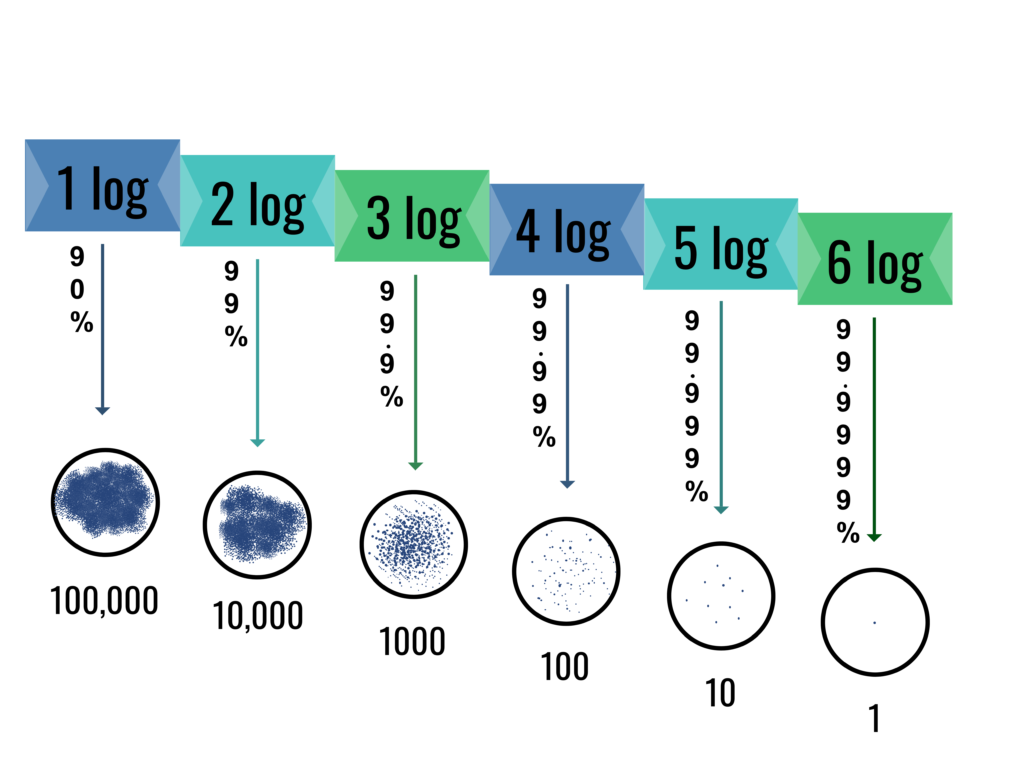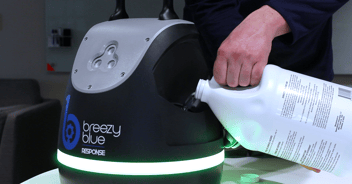
The Science Behind Disinfection
At Build With Robots, we believe that science and scientific evidence are necessary to make good informed decisions. This blog series is our attempt to help you, our users and users of equipment like ours, to better understand the science and technology behind disinfection and disinfecting solutions. These answers are derived from frequently asked questions that we get from our users. And if you do not see an answer to your question here, please reach out and ask us.
What is the Log Kill scale?
Microbiologists use a logarithmic scale when measuring a reduction of contamination by microorganisms. Log reduction stands for a 10-fold (or one decimal point) reduction in bacteria, meaning the disinfectant reduces the number of live bacteria by 90 percent for every step.
-
- 99.9% = 3 log kill
- 99.99% = 4 log kill
- 99.999% = 5 log kill
- 99.9999% = 6 log kill
- 99.99999% = 7 log kill
What are Toxicity Categories?
To help ensure the safe use and disposal of disinfection products, the EPA requires all Disinfectants to go through toxicity testing to determine any possible ill effects on humans and identify precautions that may need to be taken. The four toxicity categories, from one to four are:
-
- Category I is Highly toxic and Severely irritating, signal word DANGER,
- Category II is Moderately toxic and Moderately irritating, signal word WARNING,
- Category III is Slightly toxic and Slightly irritating, signal word CAUTION,
- Category IV is Practically non-toxic and not an irritant, no signal word required.
Breezy BioCare™ RTU is listed as at CAT IV (practically non-toxic) in five of the six toxicity areas of evaluation, and one area (eye irritation) as CAT III (slightly irritating) because of the Hydrogen Peroxide.
Who is the EPA?
The Environmental Protection Agency is part of the United States Federal Government and provides regulation and oversight for issues of environmental impact. The EPA is the Government Agency that registers Hard Surface Disinfectant products for use, validating the claims made on the product label. The US Food and Drug Administration regulates disinfection of sterile tissue, or disinfection inside the human body.
EPA Registration is a process where the US Government, through the Environmental Protection Agency, confirms that the efficacy claims, use, handling, safety and disposal instructions on disinfectant products are accurate and have been confirmed by independent, third-party testing.
Is Breezy BioCare™ RTU registered by the EPA?
Breezy BioCare™ RTU is registered by the EPA for use in fogging applications with both Breezy Blue™ and Breezy One™. The product’s Registration Number is 90748-1.
What is the EPA “N” list?
EPA List N refers to products that meet the EPA’s criteria for use against SARS-CoV-2, the virus that causes COVID-19. Breezy BioCare™ RTU is listed on the EPA List N.
What is EPA "Q" list?
EPA List Q refers to products that meet the EPA’s criteria for use against Emerging Viral Pathogens. Breezy BioCare™ RTU is listed on the EPA List Q for emerging Tier 1, Tier 2, and Tier 3 viruses such as Monkeypox and Ebola.
Has Breezy BioCare™ RTU been tested against Human Coronavirus?
Breezy BioCare™ RTU successfully passed third-party laboratory testing against Human Coronavirus in 2020 and that testing was approved by the EPA to update the EPA Registration.
What Other Pathogens does Breezy BioCare™ RTU kill?
Breezy BioCare™ RTU is a broad-spectrum disinfectant that kills a variety of bacteria, viruses and mold including: Staphylococcus Aureus, Pseudomonas Aeruginosa, Salmonella Enterica, E. Coli, Listeria, Trichophyton Mentagrophytes, Coronavirus, Norovirus, Rhinovirus, and H1N1. A Summary of Efficacy is available on the Build With Robots website.
Is there a way to independently verify the EPA data?
Test results from third-party test laboratories adhering to the Good Laboratory Practice (GLP) regulations are available from Build With Robots upon request.



